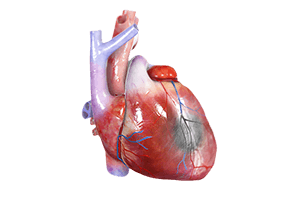
What is Heart Attack?
Heart attack, also called myocardial infarction or MI, occurs when the coronary arteries, the blood vessels that supply blood to the heart, are narrowed or blocked. This blockage deprives the heart of blood and oxygen causing damage to the heart muscle.
Causes and Risk Factors of Heart Attack
Atherosclerosis is the most common cause of heart attack due to the narrowing of the arteries that supply blood to the heart. Atherosclerosis is a condition in which fatty material called plaque builds up in the walls of your coronary arteries. The plaque can rupture exposing the fatty material within the plaque. This process promotes the accumulation of platelets at the site which can form blood clots that may further narrow the arteries and block the flow of blood.
Risk factors for heart attack that can be controlled include:
- High blood pressure
- High blood cholesterol
- Smoking,
- Obesity
- High blood sugar,
- Physical inactivity
- Stress
Uncontrollable risk factors are not under your control and include older age, family history of early heart disease, pre-existing heart disease, and post-menopausal symptoms.
Symptoms of Heart Attack
Although chest pain is the most common symptom of heart attack you may experience a variety of other symptoms including:
- Fullness or squeezing sensation in the middle of the chest
- Tightness around the chest
- Feeling of a heavyweight over your chest
- Pain may radiate from your chest to your arms, shoulder, neck, teeth, jaw, belly area, or back.
Other symptoms include:
- Indigestion
- Anxiety
- Coughing
- Fainting
- Nausea
- Vomiting
- Shortness of breath
- Light-headedness
- Dizziness
- Heavy sweating.
People with diabetes, high blood pressure, women and the elderly may experience little or no chest pain at all.Heart attacks that occur without any symptoms are called silent heart attacks.
Diagnosis
Heart Attack is diagnosed based on your signs and symptoms, medical and family histories, and other diagnostic tests such as:
- Electrocardiogram (EKG or ECG): EKG is a painless test that measures and records the electrical activity of the heart.
- Blood Tests: Certain proteins such as troponin, myoglobin and creatine kinase (CK) may be released upon the death of heart muscle. Blood tests are done to assess for the presence of these proteins.
- Coronary angiography: This test is usually done along with cardiac catheterization. During this test, a thin flexible tube called a catheter is passed into the coronary arteries and a dye (contrast material) is injected into the bloodstream. X-ray images are taken to see any blockages in blood flow.
Treatments for Heart Attack
Heart attack is a medical emergency that requires immediate first aid to increase the chances of recovery and lessen damage to the heart muscle. First aid treatment includes the following:
- Call your local emergency number immediately if you suspect a heart attack and follow the dispatchers’ instructions.
- Stay with the person and have them lie down, rest, and remain calm.
- Loosen any tight clothing.
- Have the person chew an aspirin unless they are under 18 or they have been told by their physician to never take aspirin.
- If the person has emergency chest pain medications such as nitroglycerin help them place the medicine under their tongue.
- If the person becomes unconscious, make sure they are lying on their back. Maintain a clear airway and check for breathing and a pulse.
- If the person has stopped breathing and there is no pulse, begin CPR. Cardiopulmonary resuscitation (CPR) is an emergency lifesaving procedure that is performed by pressing the patient’s chest just over the lower part of the breastbone with your hands in a pumping motion to simulate the heart beating. This is accompanied by artificial ventilation by applying 15 chest compressions followed by 2 breaths and repeated until help arrives.
Once a heart attack is confirmed by medical personnel, treatments to restore blood flow to the heart are started immediately. There are two main treatments, medicines and medical procedures.
Medicines:
- Thrombolytic medicines are used to dissolve blood clots that are blocking the coronary arteries.
- Beta-blockers may be given to decrease the workload on the heart.
- Blood-thinning medications are used to prevent the formation of blood clots in the arteries.
Medical procedures:
- Coronary Angioplasty: Also called percutaneous coronary intervention (PCI), this is a non-surgical procedure performed to open narrowed or blocked blood vessels that supply blood to the heart. A thin, flexible tube with a balloon on the end is guided to the blockage in your coronary artery. The balloon is then inflated to compress the blockage against the inside wall of your artery. This opens the artery and restores blood flow to the heart muscle. During the procedure, a wire mesh tube called a stent may also be placed in the blocked area to prevent further blockages in the artery after angioplasty.
- Coronary artery bypass grafting (CABG): This is a surgical procedure in which a healthy artery or vein is taken from another part of the body is used to bypass the blocked coronary arteries. This makes a new passage for proper blood flow to the heart muscle.
Cardiac rehabilitation programs may be recommended to help you recover and prevent recurrent heart attacks. This can include exercise instruction, education about cardiac health, and dietary counselling.
